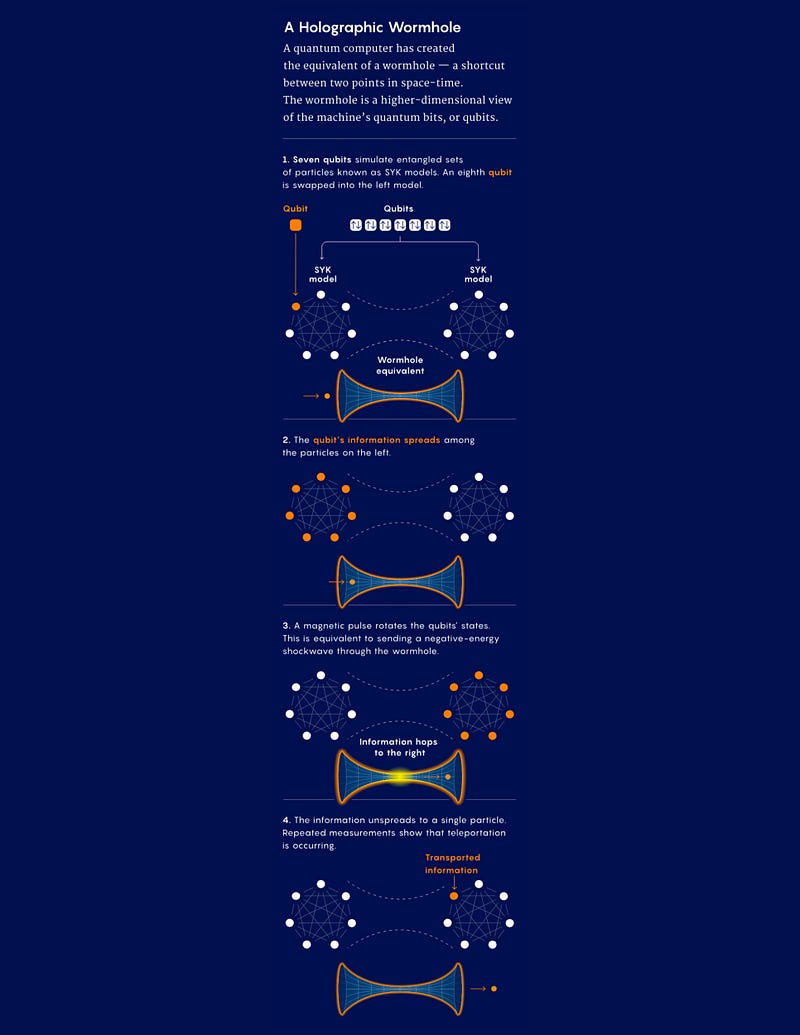Holographic Wormhole: Bridging Quantum Physics and Reality
Written on
Chapter 1: The Quantum Leap into Holographic Realities
Imagine stepping into a universe where the limits of time and space dissolve, and the essence of reality is shaped and explored through quantum mechanics. What was once a concept of science fiction has now taken a significant stride towards reality with the recent development of a holographic wormhole by leading physicists.

Under the leadership of physicist Maria Spiropulu at the California Institute of Technology, the team utilized Google's quantum computer, Sycamore, to execute an innovative "wormhole teleportation protocol." This groundbreaking achievement represents a crucial milestone in bridging the gap between the realms of quantum mechanics and general relativity.
As the team delved into the unexplored territory of quantum entanglement, they uncovered a phenomenon where particles maintain a mysterious bond, irrespective of distance. This previously overlooked connection was now front and center, its potential realized within the 54 qubits of Sycamore.
Yet, entanglement was not the only vital component. The researchers were inspired by the holographic principle, an intriguing theory suggesting that the entire universe might be encoded on a lower-dimensional boundary, akin to a vast holographic projection. This audacious idea, initially proposed by John Wheeler and further expanded upon by physicists such as Gerard ‘t Hooft and Leonard Susskind, served as the conceptual foundation for the experiment.
Section 1.1: Theoretical Foundations of Wormhole Physics
The pivotal moment arrived in 2013 when physicist Juan Maldacena introduced the ER = EPR conjecture, indicating a profound relationship between entanglement and wormholes. Building on this theory, Beni Jafferis imagined an ambitious experiment: to manipulate entangled particles to forge a traversable wormhole, a conceptual bridge linking two distant locations in space-time.
This ambitious vision became a reality in 2016 when Jafferis and his collaborators demonstrated that manipulating entangled particles could indeed stabilize a wormhole and transmit information through it. This advancement offered a sophisticated method for examining the intricate workings of these mysterious phenomena, revealing glimpses into the reality encoded within the wormhole.

Section 1.2: Overcoming Challenges in Quantum Experiments
The recent experiment built upon this rich tapestry of theoretical and experimental progress. Spiropulu and her team faced a significant obstacle: executing the complicated wormhole teleportation protocol with the limited capabilities of Sycamore. They ingeniously simplified the model, preserving its essential holographic traits with only seven qubits. This vital step, accomplished through a blend of innovative programming techniques and the expertise of team member Alex Zlokapa, brought the experiment within reach.
The culmination of their hard work occurred in a dramatic moment late one night in January when Zlokapa conducted the experiment remotely from his childhood bedroom. The success was unmistakable on the computer screen, with a pronounced peak reflecting the signature of the elusive wormhole. This was not merely the creation of a theoretical idea; it was the first concrete realization of ER = EPR, offering insights into the delicate interplay between entanglement and wormhole formation.
Alice in Wonderland: Through the Looking Glass - Full Book!
Experience the enchanting ASMR storytelling of Lewis Carroll's classic as it unfolds through captivating narration.
Jafferis speculates, “Gravity in our universe might emerge from certain quantum bits, similar to how this one-dimensional wormhole emerges from the Sycamore chip. Nevertheless, certainty remains elusive as we attempt to decipher this intricate relationship.”
Chapter 2: Implications of Quantum Discoveries
The ramifications of this experiment are profound. It not only signifies a major breakthrough in the study of quantum gravity but also underscores the vast potential of quantum computers. These powerful machines, once relegated to theoretical discussions, are now proving essential in tackling intricate problems and expanding the horizons of human understanding.
While the universe may not function as a perfect hologram, this groundbreaking achievement illustrates the remarkable advancements being made in unraveling the enigmas of space-time and the fundamental essence of reality. As we venture further into this captivating domain, the profound discoveries that lie ahead become increasingly tantalizing.

Reading of Quantum Realities: Understanding the Universe
Join an insightful reading that explores the intricacies of quantum theories and their implications for our understanding of the cosmos.